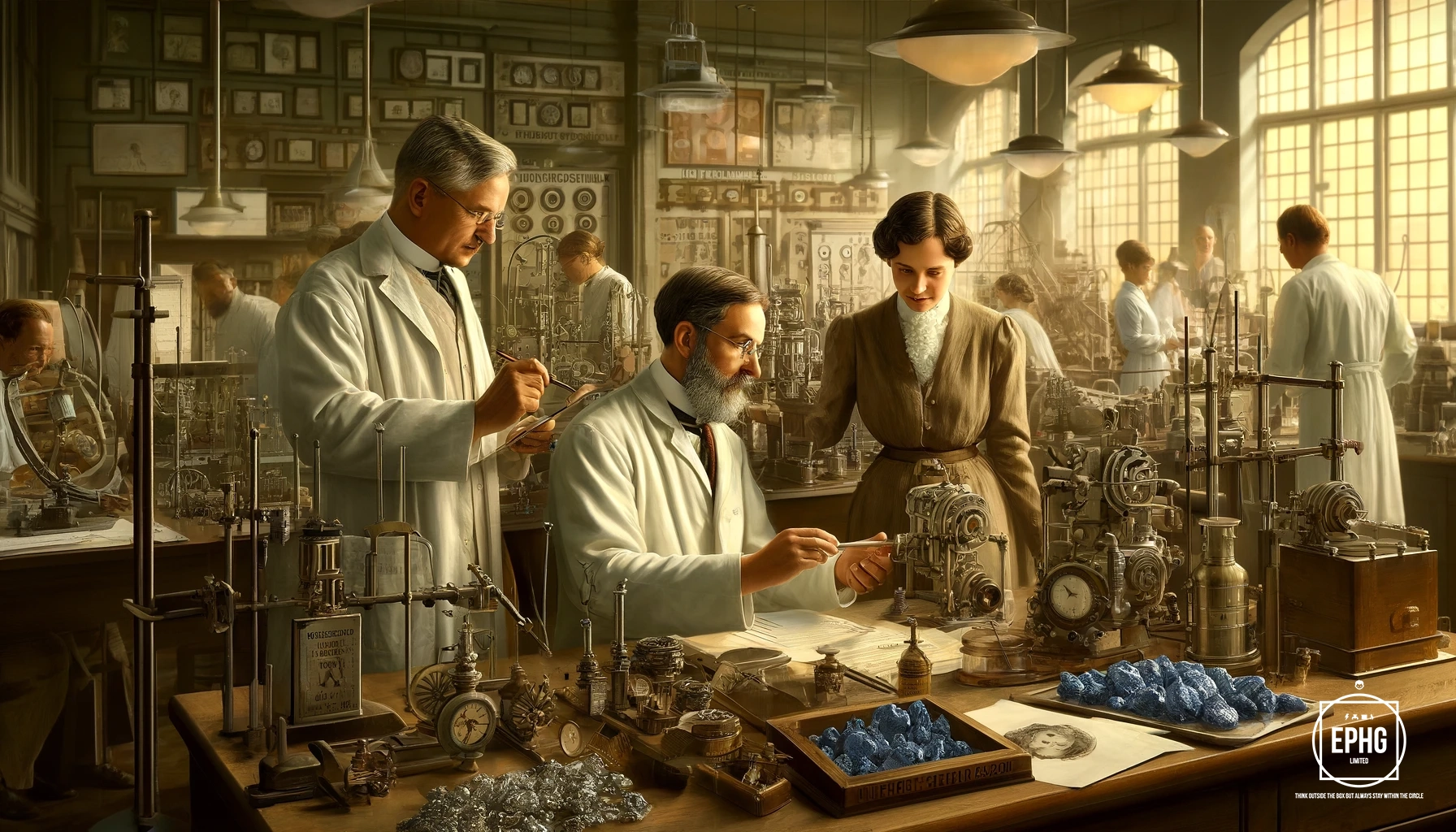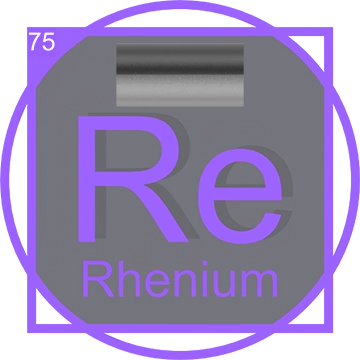Rhenium (Re): Discovery, Properties, and Technological Applications
Discovery of Rhenium
Rhenium was one of the last naturally occurring elements to be discovered, making its identification a significant milestone in the history of chemistry. The element was discovered by the German scientists Walter Noddack, Ida Tacke, and Otto Berg in 1925. Their groundbreaking research led them to detect Rhenium spectroscopically in minerals that were primarily platinum ores and columbite. The discovery was notable not only for adding a new element to the periodic table but also for its method of detection, which utilized the then-novel technique of X-ray spectroscopy that allowed for a more precise analysis of materials.

The team named the new element after the Latin name for the river Rhine, Rhenus, reflecting a tradition of naming elements to honor geographical landmarks. This symbolic naming underscored the importance of the discovery, which took place in Germany, near this major European river. The identification of Rhenium filled a previously vacant position in the periodic table, effectively validating and reinforcing the predictive power of Dmitri Mendeleev's periodic table design. Mendeleev had earlier predicted qualities of missing elements based on his periodic trends, and the discovery of Rhenium served as a testament to the accuracy of his predictions, further cementing the periodic table as a crucial scientific tool for understanding the properties of elements and their interactions.
Pure Rhenium

Pure Rhenium is a rare, silvery-white, heavy transition metal with remarkable properties that make it invaluable in a variety of high-tech applications. It boasts one of the highest melting points of all elements at 3186 degrees Celsius, exceeded only by tungsten and carbon, and maintains an exceptional resistance to corrosion even at high temperatures. This metal is also dense, with a high modulus of elasticity, making it extremely resistant to deformation. Due to these characteristics, pure Rhenium is critical in the production of high-performance aircraft engine parts, electronic contact materials, and catalytic converters. Its scarcity and unique properties not only make it a precious metal but also a crucial material for advancing modern technology.
Rhenium in the Periodic Table
Rhenium is a transition metal in the seventh group of the periodic table, symbolized by 'Re' and atomic number 75. It shares the group with manganese and technetium. As a heavy, silvery-white, transition metal, Rhenium exhibits a high melting point and remarkable resistance to wear and corrosion.
For more in-depth details about the periodic table and the placement of Rhenium, visit our comprehensive periodic table guide.
Applications of Rhenium in Technology and Industry
Rhenium in Aerospace

Rhenium enhances the properties of superalloys used in the manufacture of jet engine parts. Its addition significantly improves the strength and resistance of these alloys at high temperatures, making it indispensable for turbine blades in jet engines and gas turbines. Moreover, Rhenium's ability to maintain structural integrity at extreme temperatures also extends the lifespan of these components, reducing the need for frequent replacements and thereby increasing the efficiency of aerospace operations.
Rhenium as a Catalyst
Rhenium is a key catalyst in the petroleum refining process, particularly in the hydrogenation of fine chemicals. Its ability to withstand poisoning from nitrogen, sulfur, and phosphorus makes it highly effective for the catalytic reforming of naphtha, which helps produce high-octane gasoline. This capability not only improves the yield and quality of gasoline but also significantly enhances the environmental compatibility of the refining process by facilitating more complete and cleaner burning fuel production.
Rhenium in Electronics and Thermocouples

Rhenium is used in the production of thermocouples, which measure temperature with high precision. These thermocouples, made from Rhenium-alloyed with tungsten, are capable of measuring temperatures up to 2200 degrees Celsius, critical for industrial production processes. Their reliability and accuracy are crucial for maintaining optimal conditions in high-temperature environments, such as steel production and high-performance ceramics manufacturing.
Rhenium in Medical Applications

Radioactive isotopes of Rhenium, such as Rhenium-186 and Rhenium-188, are used in the treatment of liver and bone cancers due to their radioactive properties that provide pain relief and targeted therapy. These isotopes emit beta radiation, which is effective in killing cancer cells while minimizing damage to surrounding healthy tissue, thereby improving the quality of life for patients undergoing treatment.
Rhenium in Superconductors

The superconducting properties of Rhenium are exploited in physics research, particularly in the creation of superconducting magnets used in scientific instruments like mass spectrometers and MRI machines. These applications benefit from Rhenium's ability to conduct electricity with zero resistance at very low temperatures, leading to more sensitive and energy-efficient instruments that can provide deeper insights into the material and biological sciences.
Production and Sources of Rhenium
Rhenium is primarily obtained as a by-product of the copper and molybdenum mining processes. The metal is extracted from molybdenite ore, which occurs in combination with copper sulfides in porphyry deposits. The extraction process involves roasting molybdenum concentrate in the presence of air, which converts the sulfides to oxides and allows Rhenium to be volatilized and collected from flue gases.
Mining Locations of Rhenium

- Chuquicamata Mine, Chile - One of the world's largest open pit copper mines, also known for its molybdenum production which is a significant source of Rhenium.
- Erdenet Mine, Mongolia - A large copper-molybdenum mine where Rhenium is recovered as a by-product of copper refining.
Commonly, Rhenium is found alongside elements like molybdenum and copper, reflecting its typical co-extraction from molybdenite and other sulfide mineral processing.
Modern Applications of Rhenium
Today, Rhenium is utilized in various high-tech applications due to its unique properties. Its primary use is in the aerospace industry for making jet engine parts and rocket engine nozzles, where its high melting point and resistance to heat are invaluable. Additionally, Rhenium is critical in the petroleum industry as a catalyst for lead-free gasoline production. It is also used in the electrical industry for producing high-temperature superconductors and in medicine for cancer treatment.
The Future of Rhenium

The future applications of Rhenium are promising and diverse. Advances in aerospace technology may leverage Rhenium's properties for more efficient space travel technologies. In medicine, the radioactive isotopes of Rhenium could see expanded use in more targeted cancer therapies. Furthermore, ongoing research in renewable energy may find Rhenium-based catalysts crucial for efficient solar energy conversion and storage solutions, potentially leading to more sustainable energy systems globally.












